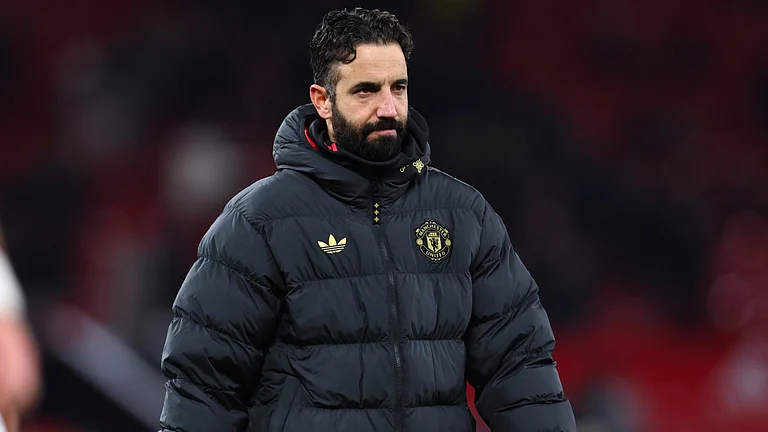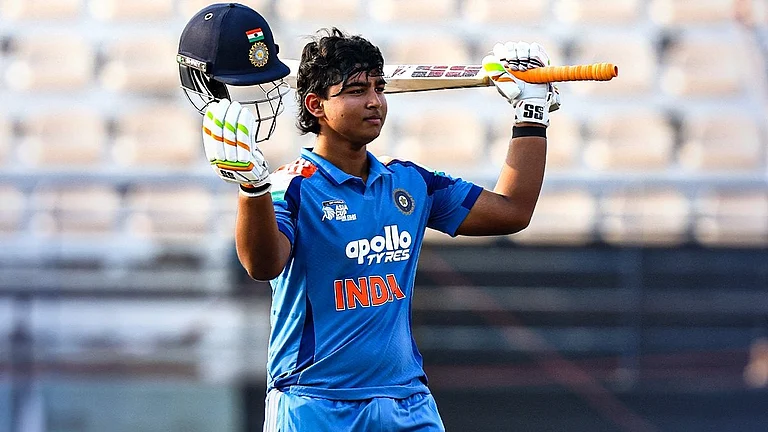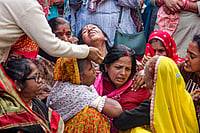Kashmiri separatist leader Yasin Malik was awarded life imprisonment by a Delhi court in a terror funding case. The sentencing came after the National Investigative Agency (NIA) sought the death penalty for convicted Kashmiri separatist and chief of banned Jammu & Kashmir Liberation Front (JKLF) leader Yasin Malik in a case of terror funding. Malik was convicted last week on Thursday by a Delhi court after he pleaded guilty to charges related to terror funding, spreading terrorism and secessionist activities in Kashmir in 2017.
However, denying NIA's demand for death penalty, Special Judge Praveen Singh awarded Malik with varying jail terms for various offences including under the stringent Unlawful Activities Prevention Act (UAPA) and the Indian Penal Code (IPC). The court also imposed a fine of over Rs ten lakh on Malik.
The life term was awarded for two offences -- Section 121 (waging war against the government of India) of IPC and section 17 (raising funds for the terrorist act) of the UAPA.
All the sentences will run concurrently.
The NIA had earlier told Special Judge Praveen Singh in in-chamber proceedings that Malik was responsible for the Kashmiri exodus.
The amicus curiae appointed by the court to assist Malik, sought minimum punishment, i.e., life imprisonment in the matter. On the point of sentence, sources said that Malik submitted that he would not “beg” for mercy, and that court could decide at its discretion.
Malik has also said that if Indian Intelligence can prove that he had been involved in any terrorist activity or violence in 28 years, then he would retire from politics, and will also accept the hanging, PTI reported.
The judge, however, said that since he has already been convicted, there was no point in arguing on the facts of the case and that he was already given the opportunity.
After hearing the arguments, the court announced its verdict on Wednesday.
Here's look at the life of Yasin Malik and why how he became a dreaded militant, then separatist leader and later a convict:
Malik started as a political activist, joined Pakistan-backed terrorism, renounced violence to pursue separatism, and has now been convicted after more than two decades of transitioning to the mainstream from overt militancy.
Here is all you need to know about Yasin Malik's life and the cases he is facing.
The year 1987 was a turning point
The year 1987 has often been called a turning point for Kashmir. It was also a turning point for Yasin Malik, who was then an activist dabbling in mainstream electoral politics.
Malik was the leader of Islamic Students League, which supported Muslim United Front (MUF) that was contesting against the National Conference (NC)-Congress alliance. Malik became the polling agent of MUF candidate Mohammad Yusuf Shah.
Shah lost the elections that were allegedly rigged in favour of the NC-Congress coalition. He moved to armed movement and went on to take up the name of Sayeed Salahuddin to become the leader of terrorist organisation Hizbul Mujahideen. Malik would go on to become the leader of Jammu Kashmir Liberation Front (JKLF), which was set up in the United Kingdom by Amanullah Khan in 1977, as per the South Asia Terrorism Portal.
This was not a trajectory unique to Shah and Malik. The alleged rigging of 1987 elections led to mass alienation in Kashmir. An earlier Outlook article noted, "This led to great disgruntlement and alienation among the people, particularly the youth, who had sought MUF to channelise their discontent."
The late Kashmiri separatist leader Addul Ghani Lone said the 1987 election motivated the younger generation to say "to hell with the democratic process" and "let's go with the armed struggle".
"The thought was there, the motivation was there, the urge was there, the demand was there, and the opposition was there. The situation became ripe, and [the elections provided] a flash-point," said Lone in an interview with political science scholar Sten Widmalm in 1994.
Yasin Malik's violent phase with JKLF
Yasin Malik transitioned from political activism to overt militancy and terrorism when he joined JKLF. He is also believed to have crossed into Pakistan for weapons training.
While most people know Malik for his involvement in the murder of four Indian Air Force personnel in Srinagar in 1990, that's just one of the 65 criminal cases against him, as per a report in The Indian Express.
"Most of them [criminal cases] are of murder, attempt to murder, rioting and sedition. Yasin Malik was involved in abducting of Rubaiya Sayeed, daughter of then Union Home Minister Mufti Mohammed Sayeed in 1989, and also involved in killing of four Indian Air Force personnel in the early part of 1990s," reported The Express, citing a National Investigation Agency investigation report.
The abduction of Rubaiya, in which Malik was involved, and the subsequent release of militants was another major movement for Kashmir.
Rediff reported that the release of the militants saw great euphoria in Kashmir. Journalist Aasha Khosa told Rediff, "There was no sympathy for Rubaiya. The people were all with the militants. When the militants were released, there was celebration all around. I have never seen so many people on the streets! They sang, danced and raised anti-India slogans."
The Air Force personnel killing
Yasin Malik's most notorious act was on 25 January 1990 when he allegedly led militants who fired at Indian Air Force personnel waiting for their morning bus in Srinagar. Four personnel were killed.
The trial in the case continues to extend even after more than three decades of the killings. The recent conviction has come in a different terror funding case.
Malik was eventually arrested in 1990.
The arrest, renunciation of violence, mainstream life
Yasin Malik was released four years later in 1994. After coming out of jail, Malik gave up violence that led to a split in JKLF, leading to two factions, one led by Malik that would work towards non-violent Kashmiri separatism and another led by Amanullah Khan that would continue with the violence.
Malik has since then been reportedly involved in back-channel talks with the government. He has been in the mainstream, even meeting the then Prime Minister Manmohan Singh at his official 7 Race Course Road residence in Delhi in 2006 and appearing in popular television shows like Rajat Sharma's Aap ki Adaalat.
Malik also gave a speech at India Today Conclave in 2008 as a youth icon and featured in a panel presided over by industrialist Anand Mahindra.
Journalist Aditya Raj Kaul wrote about his mainstreaming, "In the process, not only has India forgotten his crimes against humanity, but Yasin Malik has called himself a 'Gandhian' and has been supported by human rights activists in New Delhi, who have depicted him as a revolutionary. Thus, the mainstreaming of a separatist was complete, without him having any fear of the law, judiciary or the CBI."
The arrest and conviction in terror funding case
A Delhi court convicted Yasin Malik on Thursday in a terror funding case. Earlier, Malik had pleaded guilty to all charges, including those under the stringent Unlawful Activities (Prevention) Act.
While the case was opened in 2017, Malik was arrested in 2019. In its FIR, the NIA said Kashmiri separatists received funds from Pakistan, including from Hafiz Saeed of the Lashkar-e-Taiba and Syed Salahuddin of the Hizbul Mujahideen for activities such as stone-pelting and burning schools, according to The Indian Express.
More than a dozen separatists, including Malik and others such as Asiya Andrabi and Shabir Shah, were arrested.
The Express cited NIA as saying that Malik revealed in interrogation that he was central to the formation of the Joint Resistance Leadership that spearheaded the violent agitation in 2016 in Kashmir after the killing of Hizbul commander Burhan Wani in July 2016.
The NIA also named Kashmiri businessman Zahoor Ahmad Shah Watali as a key player who received funds from Pakistan, the ISI, and the UAE through hawala system and a number of shell companies. He would then channel them to separatist leaders and stone-pelters in Kashmir.
Framing charges against the accused, the Delhi court earlier said it was "prima facie" established that Malik and others were the direct recipients of terror funds and they had set up an elaborate structure and mechanism across the world to raise funds for carrying out terrorist and other unlawful activities in Jammu and Kashmir in the name of the "freedom struggle", according to PTI.
The maximum punishment for the charges Malik faces is life imprisonment, as per a PTI report.


























